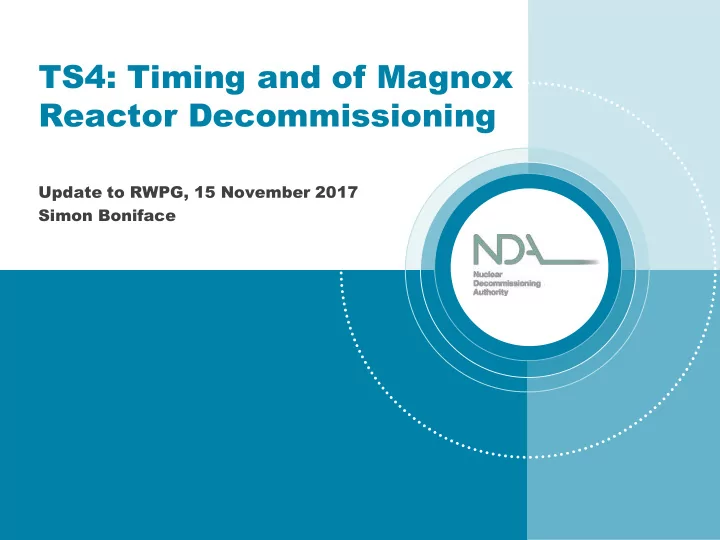

TS4: Timing and of Magnox Reactor Decommissioning Update to RWPG, 15 November 2017 Simon Boniface
Current Decommissioning Strategy
Intended Benefits of Strategy • Benefit from radioactive decay – allows for significant worker access and reduces the category of some radioactive waste • Avoids the need for interim storage of wastes pending consignment to GDF • Substantial reduction with increasing deferral of lifecycle costs on discounted basis
What has changed? • Advances in remote decommissioning show that reactors can be dismantled promptly after shutdown without significant worker access • We now have significant experience on handling and packaging of HAW at Magnox sites • HMG policies on management of HAW look to investigate alternative options for disposal where Scottish policy does not support deep geological disposal • New waste routes are available for the management of LLW to authorised landfill, the recycling of metals and the interim storage of HAW. • Work is currently underway on the sites to prepare for quiescence – if an alternative, shorter period of deferral is preferable then some of these preparations may not be needed.
Strategy Review • As promised in Strategy 3, on behalf of NDA, Magnox have developed and evaluated credible options for the timing of reactor dismantling • NDA are reviewing if a case for change can be made - no decision has yet been made • NDA review considering UK wide perspective of the Timing and Sequencing of Magnox Decommissioning
Timing of dismantling Factors that most influence Timing include: 1. Capture knowledge from one reactor to the other, making process more efficient – Lead and Learn 2. Greater momentum within supply chain, more likely to make use of innovation 3. Early clearance of site(s) to enable release for other purposes, including ‘new for old’ option for new build 4. Retention of knowledge of both condition and layout 5. Long term view of staff requirements, avoidance of loss of skilled staff 6. Greater investment in UK ‘nuclear’ skills, driving efficiency and ability to develop business within UK or abroad 7. Support BEIS Industrial Strategy 8. Greater confidence in UK nuclear overall – more likely for investment and support for new missions 9. AGR and Magnox synergies 10.Aging of plant, asset condition.
Sequence of dismantling Factors that most influence Sequencing include: 1. Waste management, interim storage or other disposal options 2. Synergies with AGR decommissioning 3. Calder Hall 4. Lead and learn from one site to another 5. Affordability, lifetime costs 6. Local factors – impact on particular sites 7. New missions – new for old 8. Management of ageing 9. Resources and ability to deploy .
OFFICIAL What we are doing • Taking Magnox work and developing into UK perspective – a case for change • Timing and Sequencing examined separately in two distinct phases • Gathering numerical underpinning of Magnox work, particularly waste generation rates, package requirements and plant ageing effects • Strategic Enablers: - Supply chain, benefits and disbenefits, UK plc contribution - Maintenance of sufficient knowledge and skills - Savings with continuous approach (no start/stop, efficiencies) - Enabling other missions i.e. release land earlier • Calder Hall • Relationship between ‘A’ Magnox and ‘B’ AGR station. • Stakeholder views – what is important? Early and ongoing discussions with SSGs / NuLeaF and Local Authorities • Developing a detailed stakeholder engagement plan to support both Timing and Sequencing phases. OFFICIAL
OFFICIAL Conclusions • NDA is considering whether a case for change of strategy can be made • Constraints such as resources and affordability will mean fleet wide acceleration not feasible • Likely to make case for between one and two sites • Will not determine all of sequence as factors may change over time • We are interested in stakeholder views as to the factors, and what matters most? • We will use the feedback to inform both the case for any change in strategy and which sites should be accelerated first OFFICIAL
OFFICIAL How to find out more Our website: www.gov.uk/nda Subscribe to receive: • E-bulletin • Blog post notifications: nda.blog.gov.uk Follow us on: • Twitter @NDAgovuk • LinkedIn Join 700+ members in: NDA Estate Supply Chain LinkedIn Group OFFICIAL
Recommend
More recommend